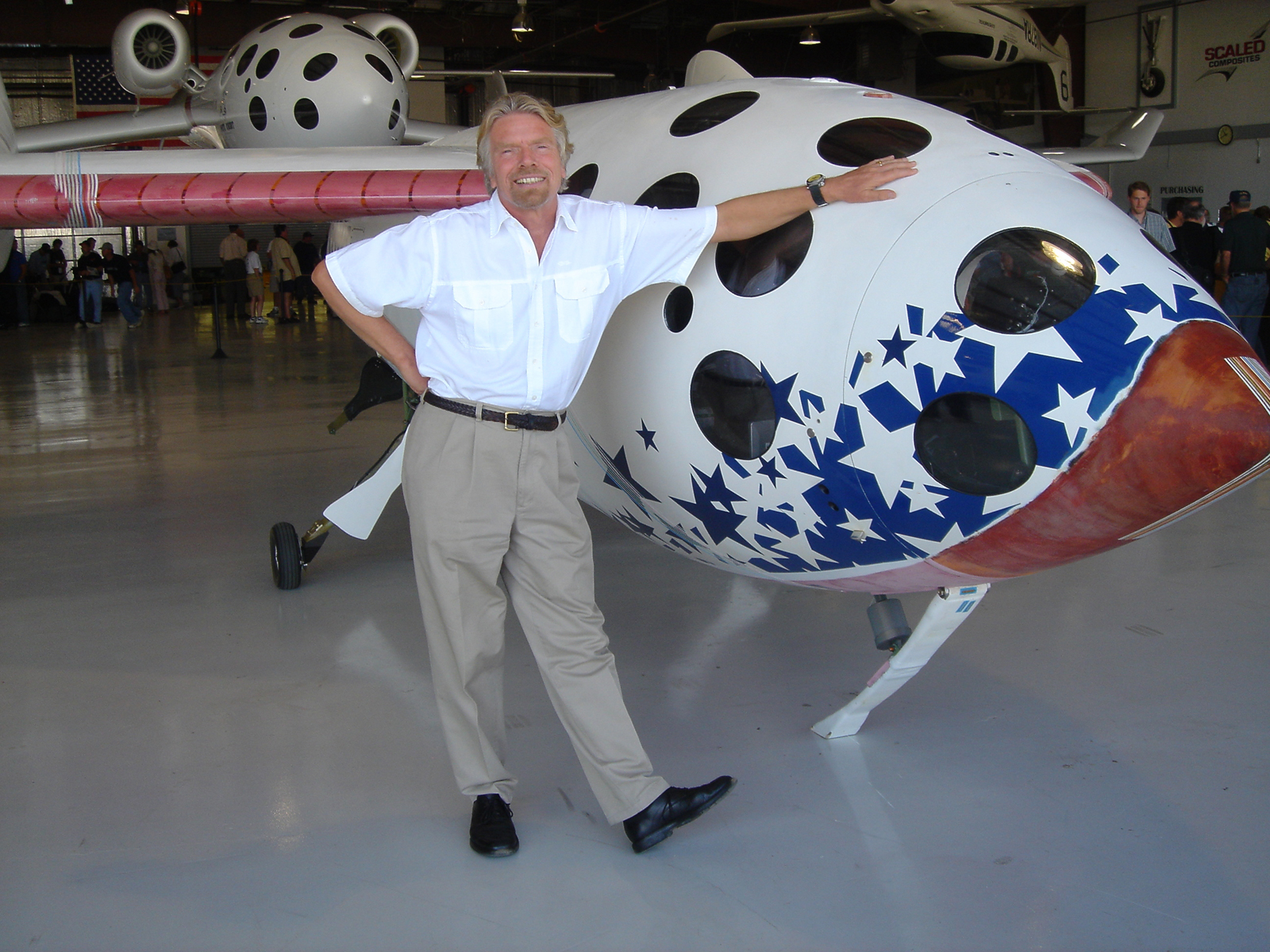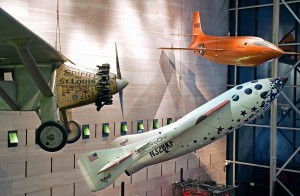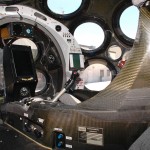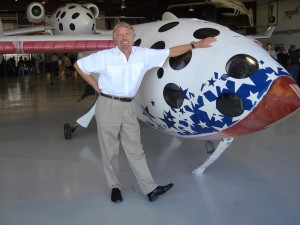
Sir Richard Branson rests his hand on SpaceShipOne, which helped win the Ansari X Prize in October 2004.
By Patty Kovacevich
Children see themselves capable of doing anything they choose, of being astronauts, explorers or movie stars, with no boundaries on their youthful dreams. However, as they get older, all too often they give up on those dreams. Until now space travel was only for a few heroic astronauts, but maybe there’s actually a way to be an astronaut no matter what the age.
Rocketing into the final frontier has been the brainchild of many futurists. Now, the future has arrived and on the horizon is a thrilling new era of suborbital space travel adventure. The blissful adventure of embarking into the unknown, escaping the forces of gravity and enjoying a thrilling, unobstructed view of the earth promises to draw ordinary citizens away from their domestic comfort zones and into breathtaking space exploration and sensory overload. The supreme adventure is upon us.
While a number of companies are scurrying to offer future suborbital spaceflights, combining utmost safety with out-of-this world luxury and planetary consciousness is fundamental to only one company. Sir Richard Branson’s Virgin Galactic plans to combine ultra-luxurious, one-of-a-kind space travel with the highest of safety standards known to mankind, while also demonstrating respect for the earth’s delicate ecological system.
Branson’s spaceliners are slated to roll out and commence test flights by late 2008, out of Mojave, Calif., with commercial operational spaceflights to be staged from his global headquarters at New Mexico Spaceport America by the end of 2009. The March 26 milestone agreement reached between Virgin Galactic and NMSA will make Virgin the anchor tenant at the Las Cruces Spaceport America facility. Spaceport design and environmental issues will be given careful concern, as the state of New Mexico prepares to launch a whole new era of discovery, exploration and commercial activity in space, on the moon and beyond.

Astronaut pilots Brian Binnie (left) and Mike Melvill helped Burt Rutan win the $10 million Ansari X Prize by completing two manned space flights within two weeks, each piloting SS1.
Additional locations for Virgin Galactic in the United Kingdom, Australia and Sweden are already underway, with Virgin’s January 2007 inauguration of its first spaceport outside the United States at Spaceport Sweden. An agreement was signed allowing the Swedish Space Corporation and Virgin Galactic to work together on an initial study of the regulatory and operational requirements for launching all initial Virgin Galactic spaceships on suborbital flights from Spaceport Sweden.
Virgin Galactic won’t commence any commercial spaceflight operations, however, until the company is entirely satisfied that it’s safe to do so. Branson is so committed to safety that he plans to have his entire family aboard the initial commercial flights as his personal demonstration of unshakable confidence in this revolutionary travel. If the flight takes place as currently scheduled, his father Ted will be 90 years old.
Virgin Galactic will offer the total experience to customers, which will include elite cosmonaut training along with posh accommodations and unforgettable adventure every step of the way. If you’re daring, healthy and willing to pay the price tag, you can become a part of history and reserve a seat now for these soon-to-launch flight excursions.
Strapped to the belly of the revolutionary mother ship WhiteKnightTwo, or Eve, named after Branson’s beloved mother, SpaceShipTwo will climb in tandem at a speed four times the speed of sound, to an altitude of around 50,000 feet (approximate cruising altitude of the Concord). WK2 will then release SS2, creating a phenomenal few seconds of freefall. SS2 will then fire her rockets and accelerate into a vertical trajectory climb, reaching a speed of 3.3 mach, or three times the speed of sound. Once she reaches an altitude of 360,888 feet, SS2 will slow to a coast, allowing passenger astronauts one of the rarest experiences of all humankind—gazing down upon Mother Earth, enjoying a thousand-mile view of the horizon while experiencing zero gravity. A scheduled five to eight unforgettable minutes will follow, quietly hovering above planet Earth and enjoying a view only a handful of earthly inhabitants have ever witnessed. A 40-second notice will instruct the passengers, now officially titled astronauts, to return
to their seats in preparation for descent.

WhiteKnightOne and SS1 begin their tandem climb, eventually traveling at four times the speed of sound.
Unlike the dangerous, fiery descent of the space shuttle, SS2 merely reconfigures its wings with “feathers” (flaps that act as brakes), allowing a safe, gentle, slow return back to Earth, to land like a plane on the same takeoff runway at Mojave Spaceport.
The massive mother ship carrier craft WK2 won’t be the cramped, strictly mechanical interiors like that of a NASA spacecraft. It will have the same ultra-luxurious interior of SS2, which will be outfitted with reclining, cushioned, leather seats and plenty of windows for viewing. Designed as a commercial vehicle, SS2 will carry six passengers and two pilots and is designed with a double-skinned hull as added safety for the passengers and pilots inside its carefully pressurized cabin.
Spacesuit designs aren’t yet complete, but they’ll be equipped with personal data and image recorders. Customers will be trained to operate their “personal communications consoles” during the flight to record their experience.
The entire flight will last about two and a half hours and cover around 200 miles. Each participant will be ceremoniously pinned with Virgin Galactic astronaut wings, a rewarding tribute to the unforgettable accomplishment and historic experience.
Branson, one of Britain’s wealthiest entrepreneurs, will own and operate all of Virgin Galactic’s privately built spaceships. SS2 will be a very light but very strong composite, a scaled version of the historic SpaceShipOne, designed and developed by Burt Rutan. Rutan, a world-renowned aerospace engineer, won the $10 million Ansari X Prize in October 2004, for successfully completing two manned space flights within two weeks. His privately-held company, Scaled Composites, LLC, in Mojave, will manufacture the first SS2 to be used for suborbital flights by Virgin Galactic.
Scaled Composites’ highly respected pilot and historic figure, 51-year-old citizen astronaut Brian Binnie, is the second privately-funded astronaut to pilot SpaceShipOne. He’s refreshingly humble about his remarkable landmark achievement to help Rutan win the Ansari prize. Mike Melvill and Binnie accomplished the remarkable piloting of two space flights within two weeks in October 2004. With almost 25 years of flight test experience, including 20 years of naval service in the Strike Fighter community, Binnie has more than 5,000 hours of flight time in 59 different aircraft and is a licensed airline transport pilot.
“The simulator training is crucial for space travel,” Binnie opines. “I think that it’s especially true for the future of citizen space travel. Virgin Galactic will require simulator training for all its pilots. I know Burt requires design of safety first and foremost and achievement of comfort design second.”
The most remarkable fact, according to Binnie, is that, unique with Rutan’s design, the rocket motor is no longer a critical safety item.
“The rocket motor itself is its own backup system,” he said. “If there’s a problem with the rocket motor, even at 50,000 feet, it can simply be shut down. It’s a hybrid motor, and at any time during the profile, the pilot can shut it down, put out the feather and glide back safely home.”
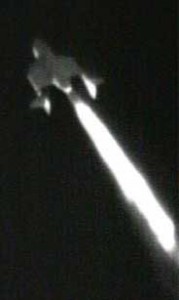
SS1 rockets upward in a vertical trajectory at approximately 2,500 mph, to reach an altitude of around 50,000 feet.
As Binnie piloted the dramatic landing of SS1 for the Ansari prize, the world watched the unforgettable, historic landing, which was accompanied by a fanfare of additional aircraft.
“The support airplanes were more flight test-specific items,” adds Binnie. “We needed safety chase airplanes. We also wanted to get video for the world to see. When SS2 comes, it may not have quite that fanfare, but it will probably be accompanied by worldwide attention; therefore, aircraft for added safety as well as filming will probably accompany the initial flights.”
Is New York to Hong Kong in an hour via space travel soon to be possible? Binnie says that over time, as this proves to be a successful commercial tourism industry, global suborbital travel will actually become a reality. He further declares that all kinds of designs are waiting to be turned into reality, once the safety of citizen space travel is well proven and the business plan demonstrates success.
Binnie also believes that as more individuals such as Peter Diamandis, chairman and president of the St. Louis-based X Prize Foundation, and Paul Allen, the cofounder of Microsoft who bankrolled SS1, offer incentive for research and development, progress and daring to reach new frontiers will accelerate.
Of course, with so many companies in the running for suborbital travel, if someone stumbles, Binnie warns that it could decelerate the progress greatly. Not only would a tragedy put a moral slowdown on moving forward, but the government would put the brakes on the industry’s progress as well.
“My present focus is on getting the next SS2 vehicle ready for flight test,” says Binnie. “We’re building a new mother ship now. I’ll help take it out into the flight test phase, to see what we’ve really brought to the playing field. Then we can hand it over to group flights at Virgin for testing opportunities. Other operators out there have also expressed interest in developing and building other space vehicles. Virgin gets first lot, of course.”
“Clean and green” technology will be used, making these spaceliners more environmentally friendly than any previously manned space vehicle. SS2 will rely on a new type of hybrid rocket fuel that’s slightly different from the rubber and nitrous oxide mixture that propelled SpaceShipOne into suborbital space in 2004. WK2 will also rely on new and cleaner-burning jet engines and will bear a close resemblance to the Virgin GlobalFlyer aircraft, which was also built by Rutan’s Scaled Composites and flew unrefueled around the world in 2005.
The ticket price of $200,000 is actually a cool bargain, considering Dennis Tito, a multimillionaire from California and the first private citizen to pay out-of-pocket for space travel aboard the Russian rockets in 2001, put down a whopping $20 million and expressed delight at doing so.
“Founders” will be the first 100 people to fly commercially and must pay the full $200,000 up front. Founder seats are available by invitation only and are currently very close to being sold out. Although more than half are from the U.S., individuals from more than 18 countries have already signed up. More than 85 percent are male and many are public figures in their own right. “Pioneers” will be the next 400 to fly, with deposits ranging from $100,000 to $175,000, depending on flight priority. “Voyagers” will fly after the first 500 and currently pay a deposit of $20,000 to secure their seats. Virgin Galactic expects to take off once a week its first year out and fly as many as 35,000 passengers over the next 10 years. Insurance coverage is currently not available for potential astronauts; however, Virgin expects coverage to be available after first flights prove safe and successful.
A required comprehensive but exhilarating, three-day, pre-flight orientation training program will be held the weekend before a passenger’s scheduled space travel, using the massive WK2 for training. The orientation will include side-by-side training with professional astronauts and participation in mock launches and reentry simulations in a centrifuge. Zero-gravity flight experiences will introduce passengers to the sensation of weightlessness.
An expert panel of spaceflight and medical advisors and trainers will work together closely to ensure each individual’s success. Passengers will learn exactly what to expect before launching into space, including G-force experience, making orientation itself the ultimate safety training thrill and physical adventure, all experienced in signature Virgin elegance.
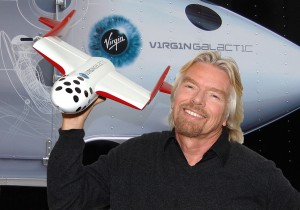
Richard Branson proudly holds a model of SS2, which will bear the Virgin Galactic name and is designed to travel strapped to the belly of WK2.
Even famed Professor Stephen Hawking has publicly expressed his long-held desire to experience space and his strong belief that space travel is critical to the future of humanity. Branson has responded with a personal offer to work with his Virgin team and Hawking to do everything possible to make that dream come true.
Initially, Virgin Galactic’s spaceflights may operate from Mojave Spaceport, if needed, until the new futuristic headquarters for the world’s first commercial spaceport are completed at NMSA.
In August 2006, Virgin Galactic announced that travel company Virtuoso, a leisure travel network of more than 6,000 elite travel specialists, considered the best in its industry, would be its exclusive retail sales group for North America. Only 45 representatives were selected as “accredited space agents,” to offer the luxurious, over-the-top, suborbital blast into space.
Being hand-picked as one of only 45 accredited space agents in the U.S. is an elite standing all unto itself; Jim Sheehy, managing director, southwest division of Protravel International, is one of those select travel agents chosen to be an accredited Virgin Galactic space agent. Protravel is one of the largest award-winning Virtuoso travel agencies in the country. Sheehy and each Virgin Galactic accredited space agent must go through intense scrutiny and a lengthy application process before being selected an ambassador for Virgin Galactic.
“As a Virtuoso consultant, Sheehy passed the test by embodying the adventurous and entrepreneurial spirit required to represent Virgin Galactic,” explains Carolyn Wincer, head of astronaut sales for Virgin Galactic. “Jim’s passion for space travel, aeronautics and astronomy, combined with his leadership and talent for selling unique travel experiences around the world, make him an ideal candidate for this new level of space.”
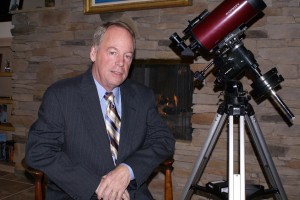
Jim Sheehy, southwest division managing director of Protravel International, is one of only a few carefully selected Virgin Galactic astronaut sales agents in the United States.
Sheehy says he has already fielded numerous phone inquiries from potential space travel adventurists in the U.S., and that he sees budding astronauts as the next generation of travelers. He adds that many people express being willing to do whatever it takes to make a thrilling space voyage possible in their lifetime. He’s careful to add that space travel is not for everyone.
“There are exceptions to every profile, but to my assessment, space travel is not for the general population,” Sheehy declares. “It’s really for someone who absolutely loves adventure, has the physical stamina to withstand the G-forces and other factors, and lastly, for one who has the financial resources to afford this experience. It’s the ideal adventure for someone who’s been everywhere, done everything and is looking for that ‘one more thing.'”
Sheehy also claims that developers are currently studying putting self-contained hotels and environments on the moon. That’s not so surprising, since the Virgin Galactic space experience is the genesis of a new era, much like the Wright brothers provided for humankind and aviation some 100 years ago.
The Virgin Galactic team has publicly claimed that space travel in the not-too-distant future will be as common and as safe as today’s air travel. It’s also noted that private industry financing and research is necessary to make it all happen. According to Will Whitehorn, president of Virgin Galactic, this new frontier of space travel will be run like a business and will also ultimately provide the foundation for what he says the project is also all about: the actual colonization of space. That vision doesn’t seem too farfetched, with more than 65,000 potential astronauts from more than 125 countries already having registered interest on Virgin Galactic’s website.
Until then, Virgin Galactic promises each person will not only be inspired and transformed by citizen space flight, but also by the experience of gazing down upon the vision of planet Earth and of looking out at 1,000 miles of space in any direction—a view that just may help us all appreciate the miracles and possibilities of life itself.
For more information on Virgin Galactic astronaut travel, call 760-346-7755, or visit [http://www.protravelinternational.com] or [http://www.virgingalactic.com].
- A view of planet Earth, taken by astronaut Brian Binnie from SS1, captures the glorious beauty that Virgin Galactic’s civilian astronauts will also see.
- WK2’s cockpit is ultra-luxurious, as is SS2’s cabin for its civilian astronauts.
- Virgin Galactic’s eye is on space travel.











